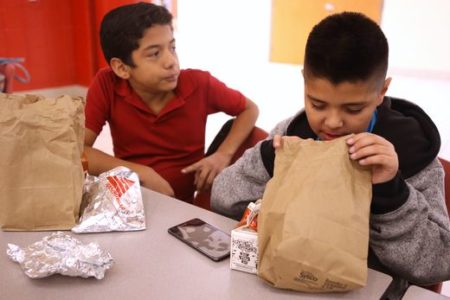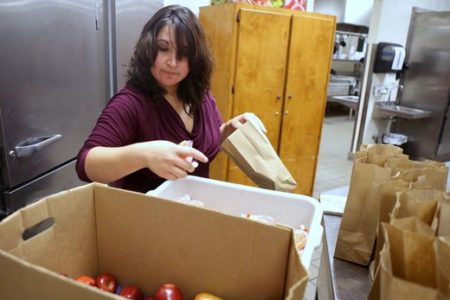Share On Social!
Tired. Unhappy. Unenergetic.
Students were showing these emotions over the school day and into afterschool activities in Robstown ISD, a 97% Latino school district in this small gulf coast town in South Texas.
Superintendent Maria Vidaurri wanted to find out why.
Turns out, they were hungry.
“Students needing to stay [after school for tutoring, sports, events] were tired, frustrated, and energy levels low,” Vidaurri said. “The last time they ate was at lunch, which is usually at 10:15 a.m. to 12 p.m.”
Vidaurri wanted to give these students the energy they needed for the school day and after school.
She also wanted to give support to local Latino families who often struggle to put food on the table. She also wanted to encourage school attendance, as two of every three Robstown ISD students are drop-out risks.
Could a school dinner program help solve all those issues?
The After-Lunch Hunger Gap
More Latinos struggle with access to healthy food than their peers, according to a Salud America! research review.
This is the case in Robstown in Nueces County, which has a higher rate of child poverty than the nation (24.3% vs 21.1%), and has more fast food restaurants and fewer grocery stores than the norm in Texas.
Robstown ISD already offers free or reduced breakfast and lunch.
But Vidaurri noticed some students were staying at school for more than 10 hours a day, with nothing to eat after lunch as they finished class and went to tutoring, sports, or other afterschool events.
The after-lunch hunger gap after lunch needed attention.
“I know it was asking a lot of our students who would be staying until 7:00/8:00PM at night, giving their all in practices and such, with nothing in their bellies,” Vidaurri said.
Robstown’s School Dinner Program
Robstown ISD applied for a grant to start an Afterschool Meals Program.

They got the grant.
They modeled their system on existing ones in Texas.
Starting in August 2017, every Robstown student can pick up a free, nutritionally-balanced sack meal as soon as school is out. Meals consist of a protein-packed main dish, a vegetable and fruit, a grain and milk. Students can take the meal home or eat with their friends in the cafeteria.
“For us, knowing that our kids had a final balanced meal before they went home was so satisfying, because we knew that some of our students were not receiving another meal once they left us that day,” Vidaurri said.
Students do not need to enroll or pay for the meal. The cost of the dinners, about $3.46 per meal, is funded by the USDA.
About 600 Robstown ISD students eat dinner at school each day.
Everyone loves the program, Vidaurri said.
- Parents: “Parents have given a lot of positive feedback. Parents are even more happy that it’s a healthy, nutritious meal that is being provided. A parent approached me and told me: ‘My family has such a busy schedule throughout the day, I was having to pick up my child, and take them for a snack after school, at least now it’s better because I’m not running to fast food options after school, and it holds my child over until dinnertime,’” Vidaurri said.
- Teachers: “The band directors, teachers, and coaches have told me ‘what a difference it has made’ when the kids stay after school. The students now have an attitude like: ‘Alright, I can go in, get things done, with no issues.’ Performance enhancements have been seen in things like (band, football, tutoring),” Vidaurri said.
- Food service staff: “Our child nutrition staff sees students from early mornings to late evenings. They have come to know students on an individual basis by building rapport with them. They know what they like or don’t like on their plates. Because of this, the students will open up to food service staff about what they have or don’t have at home. Child Nutrition staff has voiced how it makes them so happy to know that they are feeding and taking care of kids before they go home,” said Jessica Johnston, child nutrition director at Robstown ISD.
Vidaurri said the program is really helping students with energy levels for classroom and afterschool participation, too.
“After the dinner, it’s like they were just officially ready to tackle extracurricular activities and tutoring. We noticed that their behavior was a whole different dynamic than before,” she said. “Their attitude to go to tutoring improved, and this ultimately had an impact on their achievement level.”
Kids are “just being happier.”
“As educators, all we ever want is to teach and prepare our students for the future. But we also want them to be happy children,” Vidaurri said. “The dinner program has made a world of difference with our students.”
How Can You Start a School Dinner Program
To qualify for the Afterschool Meals Program, a school must be located in an area where 50 percent of children qualify for free or reduced-price meals.
Schools can use the “offer vs. serve” model, allowing students to choose the items they prefer, which cuts down on food waste and costs for the district. Texas schools have used the Afterschool Meals Program to help encourage participation in afterschool tutoring sessions and provide students with energy to do their homework or read when they get home.

“Parents are thankful that we are able to offer an Afterschool Meal to their students! Most students eat lunch anywhere from 10:30 a.m. to 1:00 p.m, so they are quite hungry when afterschool activities start,” said a representative from Austin ISD in Texas. Austin ISD has participated in the Afterschool Meals Program since 2009 and serves 3,500 students daily.
The free program helps ease students and parents minds about where their next meal will come from.
Vidaurri said the goal is to have 100 percent of students participate in the program.
Dr. Vidaurri stated that the initiative was “another way of putting our students’ needs first.”
Check out how to start an Afterschool Meals Program in your district!
By The Numbers
142
Percent
Expected rise in Latino cancer cases in coming years
This success story was produced by Salud America! with support from the Robert Wood Johnson Foundation.
The stories are intended for educational and informative purposes. References to specific policymakers, individuals, schools, policies, or companies have been included solely to advance these purposes and do not constitute an endorsement, sponsorship, or recommendation. Stories are based on and told by real community members and are the opinions and views of the individuals whose stories are told. Organization and activities described were not supported by Salud America! or the Robert Wood Johnson Foundation and do not necessarily represent the views of Salud America! or the Robert Wood Johnson Foundation.



